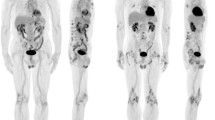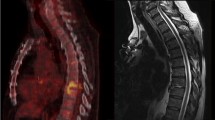Abstract
Objective
To assess the added value of serial 2-deoxy-2-[18F]fluoro-D-glucose (FDG) uptake analysis in predicting clinical response to treatment in infectious spondylodiscitis (IS). We sought to analyze changes in quantitative FDG-PET/CT parameters among patients with clinical response or treatment failure and to compare the sensitivity and specificity of serial FDG-PET/CT and MRI in predicting treatment response in IS.
Materials and methods
This retrospective study consisted of 68 FDG-PET/CT examinations in 34 patients performed before and after at least 2 weeks of antibiotic treatment. Serial MRI scans were available in 32 (94%) patients before and after treatment. FDG-avid lesions were quantified as maximum standardized uptake value (SUVmax), partial-volume corrected lesion metabolic volume (LMV), and partial-volume corrected lesion metabolic activity (LMA).
Results
All FDG-PET/CT parameters significantly decreased in patients with clinical improvement (31/34, 91%, P < 0.001), while patients with disease progression did not show FDG-PET/CT improvement. FDG uptake decrease was similar between patients undergoing early assessment (< 6 weeks) compared with those performing FDG-PET/CT after 6 weeks of treatment. SUVmax, LMV, and LMA decrease over time was 39.0%, 97.4%, and 97.1%, respectively. In predicting clinical responses, SUVmax reduction > 15% and > 25% showed 94% and 89% sensitivity and 67% and 100% specificity compared with 37% and 50% of MRI, respectively. Low degree of agreement with clinical response was shown for MRI compared with FDG-PET/CT parameters using the Cohen kappa coefficient.
Conclusions
FDG-PET/CT monitoring is a valuable tool to predict clinical response to treatment in IS and has greater sensitivity and specificity compared with MRI.




Similar content being viewed by others
References
Cottle L, Riordan T. Infectious spondylodiscitis. J Inf Secur. 2008;56:401–12.
Stäbler A, Reiser MF. Imaging of spinal infection. Radiol Clin N Am. 2001;39:115–535.
Sapico F, Montomerie J. Vertebral osteomyelitis. Infect Dis Clin N Am. 1990;77:539–50.
Deyo RA, Nachemson A, Mirza SK. Spinal-fusion surgery—the case for restraint. N Engl J Med. 2004;350:722–6.
Tyrrell PN, Cassar-Pullicino VN, McCall IW. Spinal infection. Eur Radiol. 1999;9:1066–77.
Tins BJ, Cassar-Pullicino VN. MR imaging of spinal infection. Semin Musculoskelet Radiol. 2004;8:215–29.
Skaf GS, Domloj NT, Fehlings MG, Bouclaous CH, et al. Pyogenic spondylodiscitis: an overview. J Infect Public Health. 2010;3:5–16.
Liebergall M, Chaimsky G, Lowe J, Robin GC, Floman Y. Pyogenic vertebral osteomyelitis with paralysis. Prognosis and treatment. Clin Orthop Relat Res. 1991;269:142–50.
Mahboubi S, Morris MC. Imaging of spinal infections in children. Radiol Clin N Am. 2001;39:215–22.
Galhotra RD, Jain T, Sandhu P, Galhotra V. Utility of magnetic resonance imaging in the differential diagnosis of tubercular and pyogenic spondylodiscitis. J Nat Sci Biol Med. 2015;6:388–93.
Jung NY, Jee WH, Ha KY, Park CK, Byun JY. Discrimination of tuberculous spondylitis from pyogenic spondylitis on MRI. Am J Roentgenol. 2004;182:1405–10.
Giacomuzzi F, Rensi M, Geatti O. FDG PET/CT (PET) for early evaluation of response to therapy in spondylodiscitis: experience in 80 patients. J Nucl Med. 2014;55:378.
Nanni C, Boriani L, Salvadori C, et al. FDG PET/CT is useful for the interim evaluation of response to therapy in patients affected by haematogenous spondylodiscitis. Eur J Nucl Med Mol Imaging. 2012;39:1538–44.
Bernard L, Dinh A, Ghout I, et al. Antibiotic treatment for 6 weeks versus 12 weeks in patients with pyogenic vertebral osteomyelitis: an open-label, non-inferiority, randomised, controlled trial. Lancet. 2015;385:875–82.
Bassetti M, Merelli M, Di Gregorio F, et al. Higher fluorine-18 fluorodeoxyglucose positron emission tomography (FDG-PET) uptake in tuberculous compared to bacterial spondylodiscitis. Skelet Radiol. 2017;46:777–83.
Smids C, Kouijzer IJE, Vos FJ, et al. A comparison of the diagnostic value of MRI and (18)F-FDG-PET/CT in suspected spondylodiscitis. Infection. 2017;45:41–9.
Baxi S, Malani PN, Gomez-Hassan D, Cinti SK. Association between follow-up magnetic resonance imaging and clinical status among patients with spinal infections. Infect Dis Clin Pract (Baltim Md). 2012;20:326–9.
Bassetti M, Carnelutti A, Muser D, et al. 18F-Fluorodeoxyglucose positron emission tomography and infectious diseases: current applications and future perspectives. Curr Opin Infect Dis. 2017;30:192–200.
Muser D, Santangeli P, Castro SA, Liang JJ, Enriquez A, Werner TJ, et al. Prognostic role of serial quantitative evaluation of (18)F-fluorodeoxyglucose uptake by PET/CT in patients with cardiac sarcoidosis presenting with ventricular tachycardia. Eur J Nucl Med Mol Imaging. 2018;45(8):1394–404.
Lee PI, Cheng G, Alavi A. The role of serial FDG PET for assessing therapeutic response in patients with cardiac sarcoidosis. J Nucl Cardiol. 2017;24(1):19–28.
Houshmand S, Salavati A, Hess S, Werner TJ, Alavi A, Zaidi H. An update on novel quantitative techniques in the context of evolving whole-body PET imaging. PET Clin. 2015;10:45–58.
Berbari EF, Kanj SS, Kowalski TJ, Darouiche RO, Widmer AF, Schmitt SK, et al. Executive summary: 2015 Infectious Diseases Society of America (IDSA) clinical practice guidelines for the diagnosis and treatment of native vertebral osteomyelitis in adults. Clin Infect Dis. 2015;15(61):859–63.
Garg RK, Somvanshi DS. Spinal tuberculosis: a review. J Spinal Cord Med. 2011;34:440–54.
Shankar LK, Hoffman JM, Bacharach S, et al. Consensus recommendations for the use of 18F-FDG PET as an indicator of therapeutic response in patients in National Cancer Institute trials. J Nucl Med. 2006;47:1059–66.
Fuster D, Tomás X, Mayoral M, et al. Prospective comparison of whole-body 18F-FDG PET/CT and MRI of the spine in the diagnosis of haematogenous spondylodiscitis. Eur J Nucl Med Mol Imaging. 2015;42:264–71.
Russo A, Graziano E, Carnelutti A et al. Management of vertebral osteomyelitis over an eight-year period: The UDIPROVE (UDIne PROtocol on Vertebral osteomyelitis). Int J Infect Dis 2019;89:116–121.
Prodromou ML, Ziakas PD, Poulou LS, et al. FDG PET is a robust tool for the diagnosis of spondylodiscitis: a meta-analysis of diagnostic data. Clin Nucl Med. 2014;39:330–5.
Gunes BY, Onsel C, Sonmezoglu K, et al. Diagnostic value of F-18 FDG PET/ CT in patients with spondylodiscitis: is dual time point imaging time worthy? Diagn Microbiol Infect Dis. 2016;85:381–5.
Riccio SA, Chu AKM, Rabin HR, Kloiber R. Fluorodeoxyglucose positron emission tomography/computed tomography interpretation criteria for assessment of antibiotic treatment response in pyogenic spine infection. Can Assoc Radiol J. 2015;66:145–52.
Skanjeti A, Penna D, Douroukas A, et al. PET in the clinical work-up of patients with spondylodiscitis: a new tool for the clinician? J Nucl Med Mol Imaging. 2012;56:569–76.
Blankstein R, Osborne M, Naya M, Waller A, Kim CK, Murthy VL, et al. Cardiac positron emission tomography enhances prognostic assessments of patients with suspected cardiac sarcoidosis. J Am Coll Cardiol. 2014;63:329–36.
Dibble EH, Alvarez ACL, Truong M-T, Mercier G, Cook EF, Subramaniam RM. 18F-FDG metabolic tumor volume and total glycolytic activity of oral cavity and oropharyngeal squamous cell cancer: adding value to clinical staging. J Nucl Med. 2012;53:709–15.
Basu S, Saboury B, Werner T, et al. Clinical utility of FDG-PET and PET/CT in non-malignant thoracic disorders. Mol Imaging Biol. 2011;13:1051–60.
Niccoli Asabella A, Iuele F, Simone F, Fanelli M, et al. Role of (18)F-FDG PET/CT in the evaluation of response to antibiotic therapy in patients affected by infectious spondylodiscitis. Hell J Nucl Med. 2015;18(Suppl 1):17–22.
Kowalski TJ, Layton KF, Berbari EF, et al. Follow-up MR imaging in patients with pyogenic spine infections: lack of correlation with clinical features. Am J Neuroradiol. 2007;28:693–9.
Berkowitz A, Basu S, Srinivas S, et al. Determination of whole-body metabolic burden as a quantitative measure of disease activity in lymphoma: a novel approach with fluorodeoxyglucose-PET. Nucl Med Commun. 2008;29:521–6.
Author information
Authors and Affiliations
Corresponding author
Ethics declarations
The local institutional review board approved the study. Informed consent was waived due to the retrospective nature of the study.
Additional information
Publisher’s note
Springer Nature remains neutral with regard to jurisdictional claims in published maps and institutional affiliations.
Elda Righi and Daniele Muser equally contributed to this manuscript.
Electronic supplementary material
ESM 1
(DOCX 53 kb)
Rights and permissions
About this article
Cite this article
Righi, E., Carnelutti, A., Muser, D. et al. Incremental value of FDG-PET/CT to monitor treatment response in infectious spondylodiscitis. Skeletal Radiol 49, 903–912 (2020). https://doi.org/10.1007/s00256-019-03328-4
Received:
Revised:
Accepted:
Published:
Issue Date:
DOI: https://doi.org/10.1007/s00256-019-03328-4




